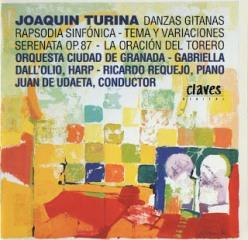Turina - Danzas Gitanas, Rapsodia Sinfónica, & other (de Udaeta) [1992]
Turina - Danzas Gitanas, Rapsodia Sinfónica, & other (de Udaeta) [1992]

1. Danzas gitanas, Op.55 1. Zambra 2. Danza de seducción 3. Danza ritual 4. Generalife 5. Saco Monte 2. Rapsodia sinfónica, Op.66 Andante-Allegro vivo 3. Tema y variaciones, Op.100 4. Serenata, Op.87 Allegro vivace-Andante-Allegro vivace-Andante 5. Oración del torero, Op.34 Ricardo Requejo - piano * Gabriela Dall'Olio - harp + Orquesta Ciudad de Granada Juan de Udaeta – conductor
The Rapsodia Sinfónica deserves the noun in its title more that the adjective: it's a brief (nine-minute) ramble on some predictable Spanish rhythms, diverting and forgettable. The American performance is the stronger of the two, paradoxically, perhaps, because it emphasises the work's lyrical, rhapsodic qualities which the Spanish players neglect in an attempt to make something bigger of it. The standard of performance varies, too: Gustavo Romero and the San Diego Chamber Orchestra are far superior to Ricardo Requejo and the sometimes scrappy Granada orchestra. The Bullfighter's Prayer – initially composed for lute quartet, soon lost, recomposed for string quartet and quickly scored for string orchestra – is likewise happier in its Californian incarnation: the playing is superior, and although the orchestra is not much smaller than the Granada group, its sound has a cutting edge which helps give the music bite.
The Danzas Gitanas, which open the Claves disc, were originally composed for piano in 1930, and were premièred in that form in 1932, Turina later orchestrating them (a second set of piano pieces followed in 1934). It's tuneful stuff, which amuses and then departs. There is a little more substance to the Tema y Variaciones for harp and strings, which was first written, for harp and piano, in 1945, and which Rafael Frühbeck de Burgos has arranged for harp and strings. The arrangement, indeed, presents harpists with a work that is pretty well new (it was premièred by the late Nicanor Zabaleta in 1979) and should well find its attractive way into the repertoire, which is hardly overburdened with works of this sort. Lastly chez Claves, there is the charming Serenata for string orchestra, also an expansion of a string-quartet original (1935); the notes make claims for the complexity of its musical language which the music itself doesn't support (it's all relative, I suppose). But it does have more substance than any other of the pieces on the Claves disc, at times belying the innocence of its title – perhaps its closest musical cousin is Debussy's Danse sacrée et danse profane. --- Martin Anderson, classical.net
download: uploaded yandex 4shared mediafire solidfiles mega zalivalka filecloudio anonfiles oboom
Last Updated (Wednesday, 11 June 2014 20:35)








